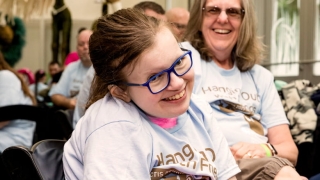CTIS Safety Registry
Your child's safety is the top priority at the Wyss/Campbell Center for Thoracic Insufficiency Syndrome at Children's Hospital of Philadelphia (CHOP). Our patients with thoracic insufficiency syndrome have severe deformities of the chest, spine and ribs preventing normal breathing, lung growth and lung development.
The only FDA-approved treatment for thoracic insufficiency syndrome is the vertical expandable prosthetic titanium rib (VEPTR).
VEPTR surgery has been performed at CHOP for nearly 10 years by orthopaedic surgeon John M. Flynn, MD, who began CHOP’s initial research and treatment of thoracic insufficiency syndrome and early-onset scoliosis, and others including Robert M. Campbell, Jr., MD, the inventor of the VEPTR, who joined CHOP in 2008.
CHOP was one of eight pioneering hospitals in the nation seeking FDA approval for VEPTR treatment and our physician-researchers continue to study the device’s impact on children and teens.
One of the most important areas of interest is safety. Dr. Campbell, Dr. Cahill and Dr. Flynn work with researchers across the country, including the Chest Wall and Spine Deformity Research Foundation, to examine surgical site infections (SSIs) related to VEPTR surgery.
In July 2013, CHOP's Wyss/Campbell Center for Thoracic Insufficiency Syndrome formed the CTIS Safety Registry to formalize safety and monitoring efforts at CHOP. Clinicians are studying every aspect of VEPTR implantation surgery, expansion surgery, revision surgery, surgical complications and long-term outcomes for the hundreds of children we treat each year.
"The CTIS Safety Registry is the latest effort from the Center in our quest for excellence," Campbell said. "We are working to produce the best outcomes for our patients with complicated conditions and to deliver care in the safest possible way."
Monitoring SSIs
An important role of the CTIS Safety Registry, coordinated by Diane M. Hartman, BSN, RN, CCRC, is to monitor the rate of surgical site infection (SSI) after VEPTR surgery.
Surgical site infections are a very real issue in the United States. Two to 5 percent of patients undergoing any inpatient surgery in the U.S. will experience an SSI, leading to more days in the hospital, increased healthcare costs, and an increased risk of serious health complications.
Children who need VEPTR treatment have thoracic insufficiency syndrome — along with other major diseases or complicated syndromes that place them at a higher-than-normal risk of SSIs. Additionally, VEPTR treatment requires multiple surgeries for implantation, expansion and revision, which also raises the risk of SSIs.
To minimize these risks, the Center has worked cooperatively with the Division of Orthopaedics to develop an extensive SSI prevention program specifically for children treated with VEPTRs.
SSI prevention program for VEPTR surgery
Here’s an overview of what we do at the Center to decrease the risk of infections before, during and after VEPTR surgery.
Before VEPTR surgery
Before surgery, we work to ensure your child is as healthy as possible. Nutrition is optimized to help your child resist infection and to help reduce skin problems over the implantable devices. In December 2013, a dedicated nutritionist for the Center will begin weekly clinics with patients who need assistance with their nutrition.
Depending on your child's needs, we may refer your child to additional specialists at CHOP. For example, skin problems which may lead to infection are referred to Dermatology.
Additional precautions:
- A pulmonologist will evaluate your child to ensure optimal pulmonary health and decrease the risk of pulmonary infections at surgery, which may contribute to SSIs.
- A nurse will give you special antimicrobial wipes to use on your child the day before surgery.
During VEPTR surgery
We take many special precautions to safeguard your child, keep the surgical field sterile and combat potential infection during VEPTR surgery. Currently, these are some of the many measures we use:
- Frequent antimicrobial washes
- Broad-spectrum IV antibiotics
- Special surgical techniques
- Antimicrobial surgical irrigation
- Plastic surgery closures when needed
- Covering wounds with Mepilex Ag (silver) antimicrobial dressings
- Dressing child in silver impregnated t-shirt before leaving the OR
- Covering instruments in the operating room with a sterile sheet
- Limiting traffic in the operating room
In addition, the Center is seeking permission from Hospital leaders to use antibiotic powder directly in wounds during surgery to further lower the risk of SSIs. CHOP surgeons currently use directly-applied antibiotic powder during all implant spine surgeries for patients weighing more than 66 pounds. Research published in The Spine Journal has proven this to be effective in minimizing SSIs for spine surgery patients.
We continue to research the effectiveness of current IV antibiotic doses — before, during and after VEPTR surgery — in providing adequate antibiotic levels in the tissues of our young patients.
After VEPTR surgery
After VEPTR surgery, your child will continue to receive prophylactic antibiotics at least for 24 hours, or longer if medically indicated. Drains are used to decrease fluid collections under wounds that might contribute to SSIs, and wounds are protected by special dressings for extended periods.
After discharge from the Hospital
After your child is discharged from the Hospital, he or she will return home to complete healing. The wound dressings can be removed 10 to 14 days after surgery.
If you are concerned about your child’s wound, especially if drainage is seen, or your child develops fever, please contact Center staff. Clinicians may ask you to take pictures of your child's wound and send them electronically for evaluation by our team.
If an SSI is suspected, Center staff will recommend that you bring your child to our clinic or the Emergency Department at CHOP for an evaluation. If you live out-of-state, CTIS staff will coordinate your child's referral to a local physician or emergency department.
Infection rates at CHOP for VEPTR surgery
Children with the most severe forms of thoracic insufficiency syndrome are referred to CHOP because of our operative expertise and outstanding postoperative support on the Pediatric Intensive Care Unit (PICU).
Our VEPTR patient volume is one of the highest in the country. Complicated patients, however, tend to have complications, and more patients means more potential complications.
The Center's surgical-site infection rate for 2012-2013 varied from an average of 5.85 percent to 6.85 percent.
In 2012, CHOP surgeons performed 179 VEPTR surgeries. Of the SSIs reported, only three cases were Methicillin-resistant Staphylococcus aureus (MRSA) surgical site infections — less than 2 percent of total surgeries. So far, our 2013 infection rate appears similar.
There is no national benchmark for MRSA after surgery. Each state has different rules for reporting these infections so comparisons on a national level are impossible at this time.
Comparing infection rates
If your child has thoracic insufficiency syndrome and needs one or more VEPTR devices, you want to know everything possible about the surgery — specifically the risks and benefits for your child, and how CHOP compares to other institutions. For the risk of infection, it is also important to know that certain diseases have higher infection rates in growth sparing surgery, like VEPTR procedures, for unknown reasons.
The best comparison would be to a large medical study of VEPTR surgery from several institutions, also detailing the effect of diagnosis on infection rates, but this is currently not available.
A study from the Chest Wall and Spine Deformity Research Foundation is expected in the future that will detail the success and complication rates of VEPTR implantation, expansion and revision surgery at multiple hospitals across the U.S. We will update this page when the new study is published and include a discussion about the study's conclusions.
In the meantime, we reviewed a recent large medical report from multiple hospitals that treat high volumes of complicated patients, including CHOP, in The Journal of Bone and Joint Surgery that examined "Surgical site infection following spinal instrumentation for scoliosis."
A total of 444 procedures were completed with growth sparing instrumentation — mostly growing rods — which require frequent surgeries (like VEPTR) to be expanded and replaced as the child grows.
The study revealed the average SSI rate per diagnosis, and certain types of procedures (e.g. implant surgery, revision surgery) within these diagnosis categories had much higher rates of SSIs. For example, the SSI rate for older adolescent patients undergoing a spine fusion for adolescent idiopathic scoliosis was 1.2 percent, but surgery for younger patients had a higher SSI rate.
Below is a list of diagnoses and the average SSI rate as reported in "Surgical site infection following spinal instrumentation for scoliosis: a multicenter analysis of rates, risk factors, and pathogens." (The Journal of Bone and Joint Surgery [American], May 1, 2013; 95(9): 800-6, S1-2. doi: 10.2106/JBJS.L.00010.)
At CHOP, our SSI rates are well below almost all categories in this published study.
| Diagnosis | Average SSI Rate |
|---|---|
| Congenital scoliosis | 3.31% |
| Infantile/juvenile idiopathic scoliosis | 11.11% |
| Neuromuscular scoliosis | 3.87% |
| Syndromic scoliosis | 11.47% |
| Other (complex) scoliosis | 7.54% |
Continued research
At CHOP's Center for Thoracic Insufficiency Syndrome, we continue to search for ways to improve care for our patients and minimize the risk of SSIs after VEPTR surgery.
While any infection is troubling, it is important to remember that SSIs are treatable. And in most situations, SSIs do not affect VEPTR's treatment goals of maximizing chest, spine and lung growth.
More information
Learn more about safety in orthopaedic surgery at CHOP and what it means for your child's care.

